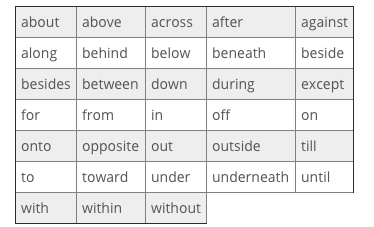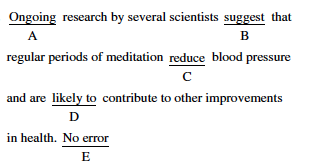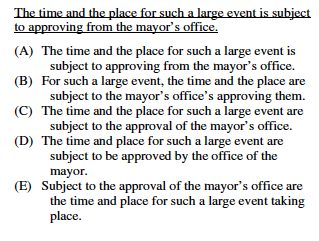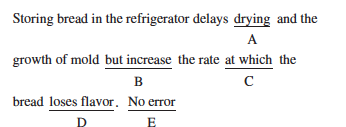
Subject-Verb Agreement may be the most tested grammatical rule on the SAT. Therefore, just by mastering this rule and its applications, you will be well on your way toward achieving a ridiculously good score on the SAT Writing.
While the rule itself is relatively simple, the questions related to it can be challenging and a bit tricky. In this article, we’ll teach you how to become a master of all things subject-verb agreement on the SAT.
In this post, I’ll do the following:
- Give you a clear understanding of subject-verb agreement.
- Explain why and how subject-verb agreement questions on the SAT can be tricky.
- Offer general strategies that can help you correctly answer subject-verb agreement questions.
- Provide you with practice questions so you can test what you’ve learned.
Review: What's a Subject?
Simply, a subject is the noun which corresponds with a verb in a sentence. In a sentence where there is an action, the subject is the noun which is doing the action. Here is an example:
Justin saved the world.
Justin is the subject because he did the saving.
In a sentence where there is a description, typically using a form of the verb “to be”, the subject is the noun which is being described. Consider this beautifully written sentence:
Justin is amazingly humble.
Justin is the subject because he is the person who is amazingly humble.
Now that we have a basic understanding of a subject, let's define this ubiquitous SAT grammar rule.
What Is Subject-Verb Agreement?
Subject-verb agreement is a rule stating that all subjects must agree with their verbs in number. Singular subjects take singular verbs. Plural subjects take plural verbs.
Most of the subject-verb agreement questions on the SAT deal with verb forms in the third-person singular form (he/she/it/one) and third-person plural forms (they).
In the present and present perfect verb tenses, third person singular verb forms end in an “s”. Third person plural verb forms do not.
Let's check out an example sentence to give you a better understanding of this rule:
The celebrity chef cook lobster and foie gras.
This sentence probably already "sounds" wrong to your ear, but let's break down exactly why. The subject of this sentence is "chef". Obviously, because we are only talking about one chef, the subject is singular. Therefore, the verb should be in the singular form. However, "cook" is the third-person plural form of the verb so this sentence is incorrect. Here is how the sentence should read:
The celebrity chef cooks lobster and foie gras.
Here's another basic example:
The gymnasts performs incredible feats of strength.
In the above sentence, the subject is "gymnasts" because they are doing the performing. "Gymnasts" is plural so the verb should be in the plural form. However, "performs" is in the singular form. This is the corrected sentence:
The gymnasts perform incredible feats of strength.
This rule is relatively basic and easy to comprehend, right? Some of you may be thinking that all subject-verb agreement errors on the SAT will be as simple to detect as they were in the example sentences above. However, in traditional SAT fashion, sentences on the SAT are intentionally deceptive and questions related to subject-verb agreement can be rather challenging.
Subject-Verb Agreement questions can deceive you
Why Are These Questions Tricky?
Generally, questions related to subject-verb agreement on the SAT can be difficult because the subject is usually not placed directly in front of the verb.
This problem appears in two ways: Interrupting Phrases, and inverted sentences where the subject follows the verb.
Common Trap #1: Interrupting Phrases
Interrupting phrases are phrases that separate the subject from the verb. Such phrases make locating the subject and determining whether the verb should be singular or plural more difficult. There are specific types of interrupting phrases and we'll take a closer look at a few of them. You don't know need to know all of the specific grammar terms, but it's important to recognize how they influence subject-verb agreement questions.
Non-Essential Clauses
Non-essential clauses are phrases describe a noun, often the subject of a subject-verb agreement question on the SAT. Non-essential clauses are surrounded by commas. These clauses can be removed without creating grammatical errors or changes in the meaning of a sentence. Take, for example, this sentence:
My doctor, who is very unfriendly, spoke to me for less than a minute.
The phrase in bold is a non-essential clause. It is separated by commas and removing the clause does not create an error or change the meaning of the sentence. The phrase is only used to provide descriptive information about the subject. See:
My doctor, who is very unfriendly, spoke to me for less than a minute.
A non-essential clause often starts with a relative pronoun (which, who, whose, or where), but it doesn't in a phrase known as an appositive. An appositive functions like a non-essential clause, but it doesn't have a verb. Here is an example:
My doctor, a very unfriendly man, spoke to me for less than a minute.
Again, the phrase provides information about the doctor, but it can be removed and will not create any errors or change the meaning of the sentence.
So, how will knowing about these phrases help you correctly answer SAT questions related to subject-verb agreement? I'll explain.
Non-Essential Clauses and Appositives on the SAT
On the SAT, these phrases will be placed between subjects and verbs to trick you into thinking a subject is singular or plural. Look at this example of an incorrectly written sentence in which I've underlined the subject and bolded the verb:
My math teacher, who is extremely demanding and yells at all the students, give too much homework.
The subject is singular and the verb is in the plural form. However, there is a non-essential clause separating the subject from the verb so it is more difficult to locate the error in subject-verb agreement.
Also, on the SAT, there will often be a plural noun in the non-essential clause placed right next to the verb in such a sentence. Many test takers will incorrectly assume that "students" is the subject, especially if you read the question quickly in one go. Here is the corrected version of the above sentence:
My math teacher, who is extremely demanding and yells at all the students, gives too much homework.

So, how do you avoid falling into this common trap that the SAT will set for you?
Strategy
For these types of questions, always cross out appositives and non-essential clauses. Doing so will make it easier to notice any issues with subject-verb agreement. The resulting sentence should be grammatically correct. Let's do this with the incorrectly written version of our previous example:
My math teacher, who is extremely demanding and yells at all the students, give too much homework.
Crossing out the non-essential clause leaves us with "My math teacher give too much homework." The subject-verb agreement error in that sentence is easy to spot.
Here is another type of interrupting phrase, probably the most common on the SAT: the prepositonal phrase.
Prepositional Phrases
Quick Review: prepositional phrase begins with a preposition. Prepositions provide additional details about nouns and often answer the questions "Where?", "When?", or provide descriptive information. Here is a chart showing examples of commonly used prepositions:
 https://study.com/academy/lesson/what-is-a-preposition-definition-uses-examples.html
https://study.com/academy/lesson/what-is-a-preposition-definition-uses-examples.html
On the SAT, prepositional phrases are often inserted between subjects and verbs to make errors in subject-verb agreement less noticeable. Take a look at this incorrectly written sentence with the prepositional phrase underlined:
Changes for the new and improved SAT is going to be implemented soon.
The subject of the sentence is "changes" and the prepositional phrase provides descriptive information about the changes. Because the subject is plural, the verb should be in the plural form.
Once again, notice how the SAT can trick you by putting a singular noun, SAT, right before the verb, "is." If you go by ear, you're likely to fall prey to this trap.
Here is the corrected version of the sentence:
Changes for the new and improved SAT are going to be implemented soon.
The approach you should take with sentences that contain a prepositional phrase is very similar to the one you should use with non-essential clauses and appositives.
My ghost writer. He knows his SAT grammar.
Strategy
Cross out the prepositional phrase and the resulting sentence should be grammatically correct. Also, doing so will make it easier for you to identify the subject and ensure that the subject and verb agree. The subject will never be contained within a prepositional phrase. Let's use the cross out method with the above incorrectly written sentence:
Changes for the new and improved SAT is going to be implemented soon.
The subject-verb agreement error is much more obvious. Hooray!
Interrupting phrases are not the only tactic the SAT uses to complicate subject-verb agreement questions.
Common Trap #2: Sometimes the Subject Will Follow the Verb
Occasionally, the normal word order of a sentence will be changed so that a prepositional phrase appears at the beginning of a sentence and the subject will follow the verb. In these sentences, it can be difficult to identify the subject and determine whether there is an error in subject-verb agreement. Take, for example, the following sentence with the prepositional phrase underlined and the verb in bold:
On my forehead resides five unsightly pimples.
We know that a subject cannot be contained within a prepositional phrase and the subject must correspond with the verb. What is doing the residing? The pimples. And "on my forehead" provides information about where the pimples are located. Because the subject is plural, the verb needs to be in the plural form:
On my forehead reside five unsightly pimples.
The correctly written sentence may sound more awkward to you because the noun "forehead" is singular and it is placed right next to the plural form of a verb. That is why you should focus on the rules and not rely on what sounds right.
In rare cases, the verb comes before the subject but is not preceded by a preposition. What? How is that possible? Check out this sentence with the subject underlined and the verb in bold:
Eating Hot Cheetos is fun, but less fun is its consequences.
In the sentence, what is less fun? The consequences. Therefore, "consequences" is the subject which corresponds with the verb. There is an error in subject-verb agreement. The sentence should read like this:
Eating Hot Cheetos is fun, but less fun are its consequences.
The order of the words has been changed, but this sentence is saying that "The consequences are less fun." So, how should you tackle sentences in which the subject follows the verb?
Strategy
In these sentences in which the subject follows the verb, simply rearrange the sentence so that it follows the normal structure of subject then verb. This will enable you to more easily spot errors in subject-verb agreement. If you did that in the incorrectly written example above, you would be left with "its consequences is less fun". The subject is right in front of the verb and the error is obvious.
Application: Real SAT Example
So, we’ve established that subject-verb agreement questions can be tricky because the subject is often not placed directly in front of the verb. Let’s see how this plays out with an actual SAT question. First, let's look at a sentence with an interrupting phrase.

The subject of this sentence is “research”. The phrase “by several scientists” is a prepositional phrase providing descriptive information about the research. Therefore, the subject is singular and the verb should be in the singular form. If you get rid of the prepositional phrase, the sentence reads "research suggest". B is the answer; the word should be “suggests”.
There are additional situations which complicate the most basic questions that test subject-verb agreement. Now we'll take a look at some of these specific situations.
 More grammar fun. Get excited!!!
More grammar fun. Get excited!!!
Common Trap #3: Compound Subjects
If the subject is two singular nouns connected by “and”, then the verb should be in the plural form. Here is an elementary sentence illustrating this rule:
Justin and the SAT are friends.
The subject is both Justin and the SAT so the verb needs to be in the plural form.
Here is a more difficult SAT-style example in which a prepositional phrase is also placed at the beginning of the sentence:
Under my bed exists a pen and a Taco Bell receipt from 1994.
So, where is the subject? "Under my bed" is a prepositional phrase - that's not the subject. What exists? Both a pen and a Taco Bell receipt. We can rearrange the sentence order so that the sentence reads that "A pen and a Taco Bell receipt exists". Because there is a compound subject, the verb should be in the plural form. This is the corrected version of the sentence:
Under my bed exist a pen and a Taco Bell receipt from 1994.
Application: Real SAT Example
Here is an example of an actual SAT subject-verb agreement question that uses a compound subject.

The subject is both the time and the place. Therefore, the verb should be in the plural form. Also, there is an additional error in the sentence in that “to approving” should be “to the approval”. The correct answer is C.
Collective Nouns
Another unique situation that affects subject-verb agreement involves the use of collective nouns. Collective nouns are singular nouns that refer to groups of people. On the SAT, these nouns, if used in the singular form, should be used with singular verbs. Examples of collective nouns include team, band, company, and committee.
Keep in mind that subject-verb agreement questions with collective nouns are rare, but I have seen this type of question on actual SATs. This is what the sentence would look like:
After losing by thirty points, the basketball team have decided to fire its coach.
Even though there are multiple people on a team, the subject is referring to one team. Therefore, the subject is singular and the verb should be in the singular form. This is corrected version of the sentence:
After losing by thirty points, the basketball team has decided to fire its coach.

Other Singular Subjects That Can Be Tricky
Aside from collective nouns, there are other specific types of subjects that may intuitively appear to be plural but are singular and require a singular verb.
Each=Singular
The word “each” implies that you’re referring to each thing individually so you should use a singular verb when “each” is the subject. This is an example of an incorrectly written sentence using "each" as the subject:
Each of the members of the team are athletic.
Keep in mind that "of the members" and "of the team" are prepositional phrases. After removing the prepostional phrases, the sentence reads "Each are athletic." Each is our subject so the verb should be singular. This is the correct version:
Each of the members of the team is athletic.
Every=Singular
Similarly, the word “every” implies that you’re referring to each thing individually. Think of the word “every” as implicitly stating “every one”. Here is an example of this rule in effect:
Every person in each of my classes are intelligent.
Although all of the students are intelligent, this sentence is stating that every single student is intelligent. Also, the use of the singular noun "person" further indicates that the subject is singular and requires a singular verb. Remember that "in each of my classes" is a prepositional phrase. This is how the sentence should look:
Every person in each of my classes is intelligent.
Gerunds When Used as Subjects=Singular
A gerund is a verb which is used as a noun and ends in “ing”. When a gerund is being used as a subject, then the subject is singular. Look at this example:
Remembering the names of all of the Kardashian sisters are easy.
To determine the subject, think about what is easy. Also, we know that "of all of the Kardashian sisters" is a prepositional phrase which we can cross out and will not contain the subject. Therefore, we're left with "Remembering the names are easy". Even though "names" is plural, "the names" is not the subject and simply provides additional information about what we're remembering. The subject is "Remembering", a gerund which requires a singular verb. So, here is the corrected version:
Remembering the names of all of the Kardashian sisters is easy.

Who is this?
Application: Real SAT Example
It's time to take a look at an actual SAT subject-verb agreement question that includes one of these uniquely singular subjects.

The subject is the gerund “storing”, which is singular. Therefore, the verb should be “increases” and the answer is B. Also, because “delays” is singular and shares the same subject, you should know that any verb which corresponds with the same subject should be in the singular form as well.
Now that we've looked at various types of subject-verb agreement questions, let's go over strategies you can use on your SAT to help determine if you're encountering a subject-verb agreement question and ensure that you answer the question correctly.
Ready to go beyond just reading about the SAT? Then you'll love the free five-day trial for our SAT Complete Prep program. Designed and written by PrepScholar SAT experts, our SAT program customizes to your skill level in over 40 subskills so that you can focus your studying on what will get you the biggest score gains.
Click on the button below to try it out!
General Strategies for SAT Subject-Verb Agreement
Look For Errors in Subject-Verb Agreement When a Verb is Underlined
In any of the subsections (sentence improvement, identify the error, paragraph improvement), if a verb is underlined, make sure that there are no errors in subject-verb agreement.
Always Identify the Subject
Both subjects of sentences and subjects of clauses must agree with their verbs. For each verb, find the noun which corresponds with that specific verb. Then, determine whether that subject is singular or plural and make sure that the subject and verb agree.
The Subject is Never Part of a Prepositional Phrase
Be aware that the subject will not be part of a prepositional phrase. Most subject-verb agreement questions on the SAT separate a subject from a verb with a prepositional phrase.
Cross Out Interrupting Phrases
The SAT tries to deceive you by placing long phrases in between the subject and the verb. Often, the number of the noun closest to the verb will not match the number of the subject. By crossing out the interrupting phrase, you will have an easier time identifying the subject and determining whether there is an error in subject-verb agreement.
Be Able to Recognize the Common Tricks
Knowing the common tricks the SAT uses on questions that test your knowledge of subject-verb agreement can be helpful. The better you know these tricks, the more quickly you’ll be able to identify them and correctly answer subject-verb agreement questions.
Additional Practice
Hopefully, by this point you thoroughly understand subject-verb agreement and how to correctly answer any subject-verb agreement question that may appear on the SAT. I've created some practice problems to test you on what you've learned. Remember to use the general strategies I referenced above.
 If you're not having fun, you're not doing it right.
If you're not having fun, you're not doing it right.
1. Every summer in Los Angeles (A) the sound of children yelling (B) at the beach on a weekday indicate (C) that it is summer vaction (D). No error (E)
2. The selfie, which is (A) a photograph taken (B) by many narcissistic people, is (C) extremely popular on various social networking websites (D). No error (E)
3. An effective and helpful (A) tutor demonstrates (B) exceptional knowledge, is responsive to the needs (C) of her students, and listen (D) to them carefully. No error (E)
4. Extremely careful analysis (A) of handwriting samples show (B) that creative people are more likely to write (C) rounded letters (D). No Error (E)
5. Playing sports (A) such as basketball, football, or baseball allow (B) children to learn teamwork (C) and develop (D) coordination. No error (E)
Answers: 1. C, 2. E, 3. D, 4. B, 5. B
What's Next?
If you want to know everything that is tested on the SAT Writing section, read our article about what's actually on SAT Writing. After you have mastered the basic questions, study the hardest SAT Writing questions.
Finally, if you're aiming for an 800 on SAT Writing, find out how to get a perfect score from a perfect scorer.
Want to improve your SAT score by 160 points?
Check out our best-in-class online ACT prep program. We guarantee your money back if you don't improve your ACT score by 4 points or more.
Our program is entirely online, and it customizes what you study to your strengths and weaknesses. If you liked this Writing and grammar lesson, you'll love our program. Along with more detailed lessons, you'll get thousands of practice problems organized by individual skills so you learn most effectively. We'll also give you a step-by-step program to follow so you'll never be confused about what to study next.
Check out our 5-day free trial:
Have friends who also need help with test prep? Share this article!

Justin has extensive experience teaching SAT prep and guiding high school students through the college admissions and selection process. He is firmly committed to improving equity in education and helping students to reach their educational goals. Justin received an athletic scholarship for gymnastics at Stanford University and graduated with a BA in American Studies.





































 Holly R.
Holly R.